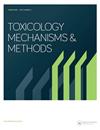一种利用3D生物打印的人肝组织确定药物性肝毒性的新评估方法
IF 2.8
4区 医学
Q2 TOXICOLOGY
引用次数: 9
摘要
摘要预测药物性肝损伤在药物发现的早期阶段具有重要意义;然而,使用现有的肝毒性评估工具进行准确预测是困难的。传统的单层(2D)培养物具有较短的存活率,因此不适合进行长期毒性测试。常规使用的200μm球体也有毒性检测限值。本研究的目的是开发一种能够高灵敏度评估长期毒性的人源化肝组织。使用3D生物打印机开发了由共培养的冷冻保存的原代人肝细胞和人肝星状细胞组成的球体。“3D生物打印肝组织”,约1 mm,然后用于长期生存能力评估(超过25 天)。通过分析在2周的药物暴露期内参与药物代谢和转运的基因的表达来进行肝毒性评估。与对照组相比,3D生物打印的肝组织显示出提高的生存能力和增强的与药物代谢和转运相关的酶的基因表达。此外,3D生物打印的肝组织在与病理学评估和ATP产生以及白蛋白和尿素分泌的测量相结合时,显示出对肝毒性评估的高灵敏度。总之,3D生物打印的肝组织能够检测化合物的毒性,否则,2D培养和常规使用的球体无法检测到这些化合物的毒性。这些发现表明,与目前可用的方法相比,3D生物打印的肝组织在药物发现的早期阶段具有更高的肝毒性预测准确性。本文章由计算机程序翻译,如有差异,请以英文原文为准。
A novel evaluation method for determining drug-induced hepatotoxicity using 3D bio-printed human liver tissue
Abstract Predicting drug-induced liver injury is important in early stage drug discovery; however, an accurate prediction with existing hepatotoxicity evaluation tools is difficult. Conventional monolayer (2D) cultures have short viabilities and are therefore inappropriate for performing long-term toxicity tests. Conventionally used 200-μm spheroids also have toxicity detection limits. The goal of this study was to develop a humanized liver tissue capable of evaluating long-term toxicity with high sensitivity. Spheroids consisting of co-cultured cryopreserved primary human hepatocytes and human hepatic stellate cells were developed using a 3D bio-printer. The “3D bio-printed liver tissue”, of ∼1 mm, was then used for long-term viability assessments (over 25 days) based on ATP, albumin, and urea levels. Hepatotoxicity evaluation was performed by analyzing the expression of genes involved in drug metabolism and transport over a 2-week drug exposure period. The 3D bio-printed liver tissue showed improved viability and enhanced gene expression of enzymes related to drug metabolism and transport, as compared to the controls. Additionally, the 3D bio-printed liver tissue demonstrated a high sensitivity for hepatotoxicity evaluation when combined with pathological evaluation and measurements for ATP production, and secretion of albumin and urea. In conclusion, the 3D bio-printed liver tissue was able to detect the toxicity of compounds that was, otherwise, undetected by 2D culture and conventionally used spheroids. These findings demonstrate a 3D bio-printed liver tissue with increased accuracy of hepatotoxicity prediction in the early stages of drug discovery, as compared to currently available methods.
求助全文
通过发布文献求助,成功后即可免费获取论文全文。
去求助
来源期刊

Toxicology Mechanisms and Methods
TOXICOLOGY-
自引率
3.10%
发文量
66
期刊介绍:
Toxicology Mechanisms and Methods is a peer-reviewed journal whose aim is twofold. Firstly, the journal contains original research on subjects dealing with the mechanisms by which foreign chemicals cause toxic tissue injury. Chemical substances of interest include industrial compounds, environmental pollutants, hazardous wastes, drugs, pesticides, and chemical warfare agents. The scope of the journal spans from molecular and cellular mechanisms of action to the consideration of mechanistic evidence in establishing regulatory policy.
Secondly, the journal addresses aspects of the development, validation, and application of new and existing laboratory methods, techniques, and equipment. A variety of research methods are discussed, including:
In vivo studies with standard and alternative species
In vitro studies and alternative methodologies
Molecular, biochemical, and cellular techniques
Pharmacokinetics and pharmacodynamics
Mathematical modeling and computer programs
Forensic analyses
Risk assessment
Data collection and analysis.
 求助内容:
求助内容: 应助结果提醒方式:
应助结果提醒方式:


